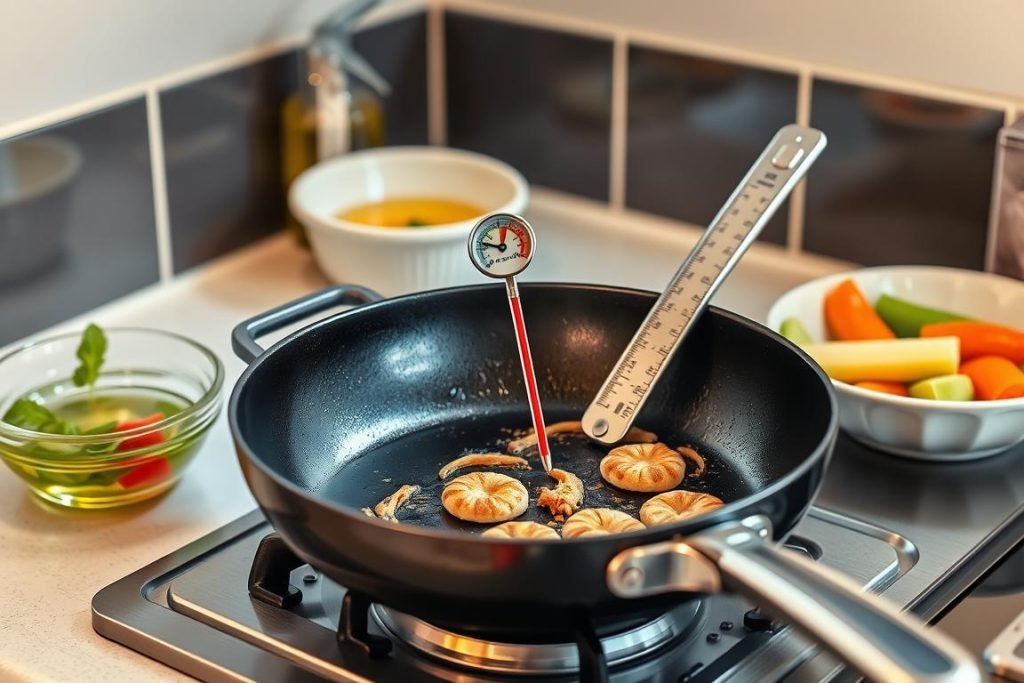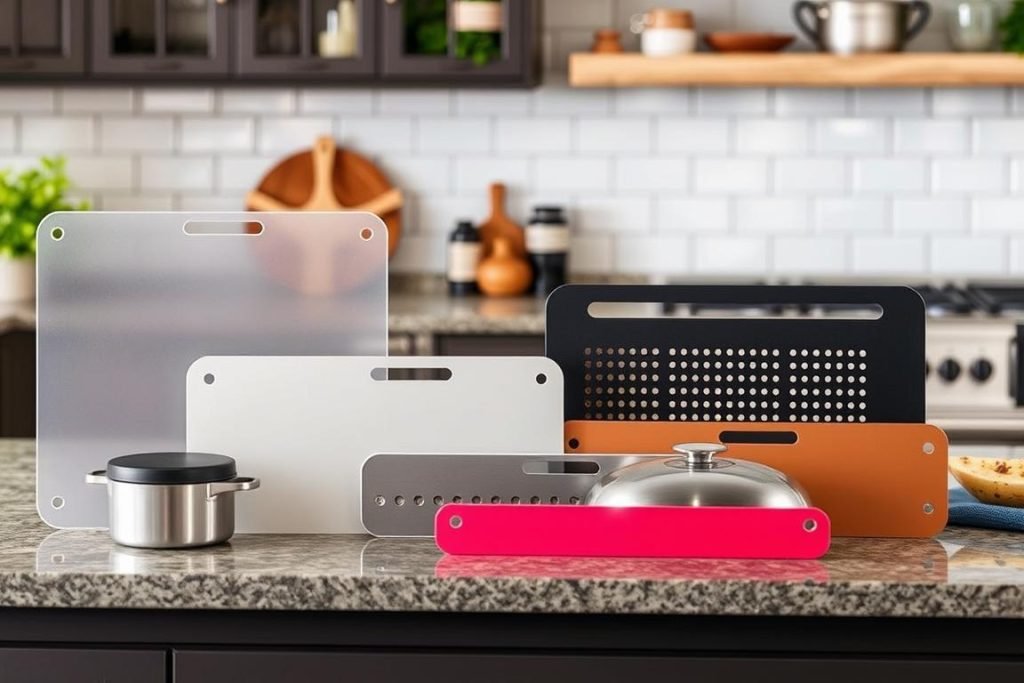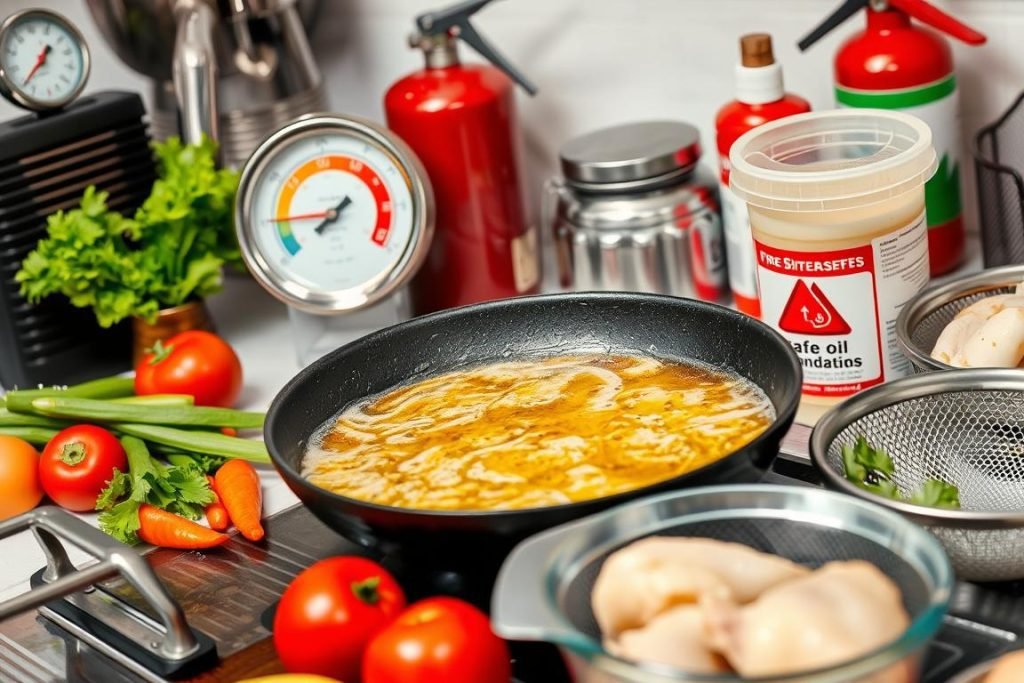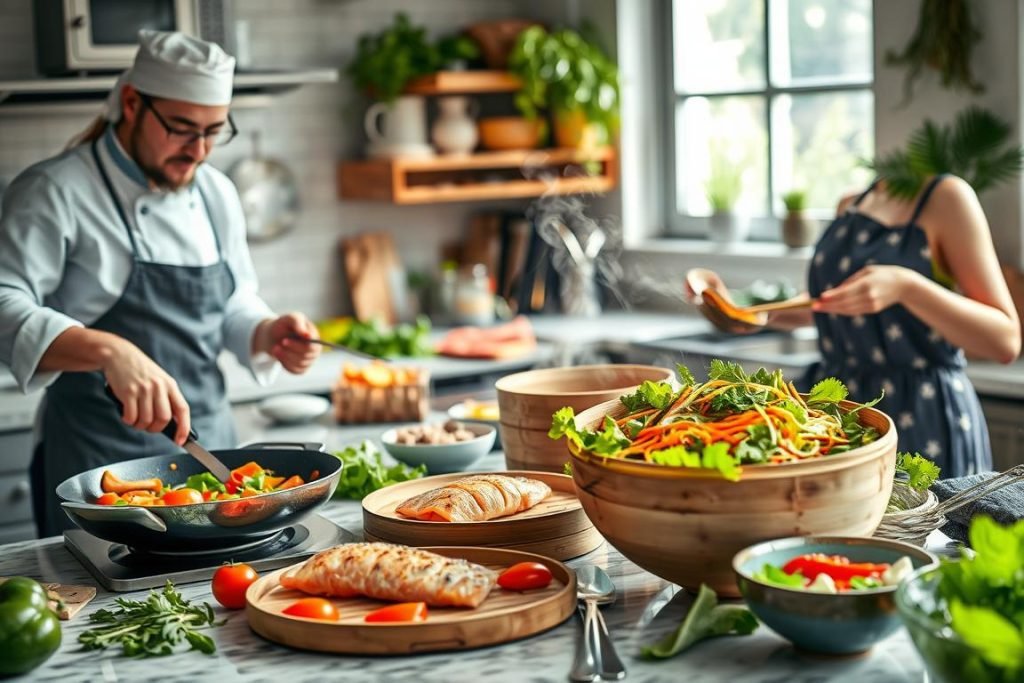The Ultimate Frying Temperature Guide

Have you ever wanted to make your fried foods perfect? The secret is all about the right temperature. This guide takes you deep into the world of frying. You will learn how temperature is key to making your food crispy outside and tender inside. It’s also crucial for keeping your kitchen safe and avoiding accidents while frying.
Knowing how hot the oil should be can change everything. It’s not just about the oil being hot enough. It’s also choosing the right oils like palm, peanut, and canola. These oils can handle the heat. This guide will show you how to keep an eye on the temperature. That way, you get that perfect golden crunch every time. It covers everything you need to know about temperature control and staying safe in the kitchen.
Key Takeaways
- Deep-frying perfection requires maintaining oil temperatures between 160 and 180 degrees Celsius.
- Choosing oils like palm, peanut, and canola for their high smoke points leads to optimal deep-frying outcomes.
- Implementing kitchen safety protocols while deep frying is essential to prevent fires and ensure great taste.
- Using a cooking thermometer is crucial for accurately measuring oil temperatures for different foods.
- Cleaning and proper storage of frying equipment and oils extend their usability and impact food quality.
- Deep frying precautions, from oil selection to temperature control, enhance both the culinary experience and safety in the kitchen.
Understanding Frying Temperature Basics
Learning how to fry starts with knowing the right temperatures. This is key to getting foods crispy without them being greasy or burnt. Properly handling hot oil and keeping your fryer clean are very important.
Why Temperature Matters in Frying
Keeping the right temperature is very important in frying. It affects the food’s texture and safety. If the temperature’s wrong, food can soak up too much oil, become too greasy, or might not cook well, which is unsafe. Keeping the oil between 350-375 degrees Fahrenheit means your food will cook well inside. For chicken, it should reach 165 degrees Fahrenheit inside, and fish should reach 145 degrees Fahrenheit. This way, food gets a nice golden crust.
Common Frying Methods
There are two main ways to fry: deep frying and shallow frying. Deep frying means covering the food completely in oil. It needs careful temperature control to cook evenly and keep the oil good. In shallow frying, food cooks in a little oil in a wide pan. You also have to watch the oil to stop it from burning.
Recommended Equipment for Frying
If you want to get better at frying, having the right tools is a big help. Key items include:
- Deep fryers with adjustable thermostats for precise temperature control, perfect to match the heat needs for various foods.
- Cooking thermometers to make sure oil temperature stays safe and right for cooking.
- Splatter guards and tongs with long handles to keep you safe from hot oil splatters.
Using these tools helps keep your cooking oil in good condition, cuts down on waste, and can make your fried food better.
Keeping high standards in hot oil handling and fryer care makes frying safe and tasty. Check out the best oils, temperatures, and tools before frying next time. You’ll see the taste and quality difference.
| Frying Item | First Fry Temperature | Second Fry Temperature | Food Safety Internal Temp |
|---|---|---|---|
| Chicken | 350-375°F | N/A | 165°F |
| Fish and Shellfish | 350-375°F | N/A | 145°F |
| French Fries | 325°F | 375°F | N/A |
| Mozzarella Sticks | 350°F | N/A | N/A |
Using these tips on temperatures and tools makes frying safer and makes everyone happy. From crispy fries to golden mozzarella sticks, it all gets better.
Oil Selection for Frying
Picking the right oil for frying is key. It helps keep things safe, tasty, and cooks well. Each oil behaves differently under heat, affecting the food’s taste and healthiness.
Types of Oils and Their Smoke Points
An oil’s smoke point tells us how hot it can get before smoking. This matters because smoking oil can create Cooking Oil Hazards. Below is a table of various oils and their smoke points:
| Oil Type | Smoke Point |
|---|---|
| Butter | 300-350°F (149-175°C) |
| Coconut Oil | 350-385°F (175-196°C) |
| Vegetable Oil | 400-450°F (204-230°C) |
| Corn Oil | 410-450°F (210-230°C) |
| Extra Virgin Olive Oil | 325-410°F (163-210°C) |
| Animal Lard | 370°F (188°C) |
| Peanut Oil | 440-450°F (227-230°C) |
| Canola Oil | 400-450°F (204-230°C) |
| Soybean Oil | 450-495°F (230-257°C) |
| Avocado Oil | 520-570°F (271-299°C) |
Flavor Profiles of Different Oils
Flavor is important in choosing frying oil. Mild oils like canola fit many dishes. In contrast, coconut and olive oils add unique flavors, good for certain recipes.
Best Oils for High-Temperature Frying
Oils like avocado, canola, and peanut are best for hot frying. They have high smoke points, which stop Cooking Oil Hazards. This makes frying quick and prevents soaking up too much oil.
Ventilation for Frying matters a lot, too. It helps remove smoke and smells, making the kitchen safer and air clearer.

Frying Temperatures for Different Foods
Getting frying temperatures right is key for great cooking and kitchen safety. It helps with things like Grease Fire Prevention and Burn Prevention. Let’s look at how different foods do well with certain temperatures. This makes food tasty and keeps cooking safe.
Vegetables: Ideal Temperatures for Frying
Fry vegetables like French fries at 160°C first and then make them crispy at 180°C. This method is called blanching and finishing. It makes veggies crispy but keeps them moist inside. Onion rings and tempura need to be fried at around 180°C for the best crunch without overcooking.
Meat and Poultry: Safety and Taste
Meat and poultry taste best and are safest when fried at the right temperatures. For example, chicken is best fried between 350 and 375 degrees Fahrenheit. This makes the outside crispy and cooks the inside safely. It also helps to prevent Burn Prevention by cooking evenly and reducing splatter.
Seafood: Perfecting Frying Techniques
Seafood needs careful temperature control. Fry things like butterfly shrimp and battered fish at 350 to 375 degrees Fahrenheit. This keeps the outside crispy and the inside moist and flaky. It also means less oil gets absorbed, making seafood lighter and healthier.
Knowing how to fry different foods well improves taste and is important for Grease Fire Prevention. Managing the right temperature makes oil heat evenly. This avoids oil reaching a smoke point that could start a fire. It keeps both the cook safe and the food tasty.

Frying Techniques: Deep vs. Shallow Frying
Knowing the difference between deep and shallow frying is key for cooks. Deep frying means dipping food in hot oil. The oil’s temperature must stay right to cook food well. Shallow frying uses less oil. The food touches the hot oil and cooks in two ways. It is crucial to watch the oil and food when you shallow fry.

Pros and Cons of Deep Frying
Deep frying cooks food fast and makes it crispy. It seals in the yummy flavors. You get a nice, even golden cover. But, it’s important to use splatter guards when deep frying. They keep oil from splashing and making a mess or causing burns. Deep frying also means using lots of oil. This can cost more and needs careful disposal to protect nature.
Benefits of Shallow Frying
Shallow frying needs less oil, making it a healthier choice. You can easily reach the food to add spices or flip it. This ensures it gets crispy on all sides. Foods get a tasty outside and stay moist inside. This is great for pan-fried fish or chicken cutlets.
When to Choose Each Method
Choosing between shallow or deep frying depends on what you want. Also, it matters what food you’re cooking. Below is a table showing when to use each method for some dishes:
| Recipe Type | Recommended Frying Technique | Ideal Oil Temperature |
|---|---|---|
| Fried Chicken | Deep Frying | 365°F–370°F |
| Apple Fritters | Deep Frying | 365°F–370°F |
| Chicken Corn Fritters | Shallow Frying | 350°F–355°F |
| Pan-Fried Fish | Shallow Frying | 350°F–355°F |
Whatever method you choose, remember safety first. Use Deep Frying Precautions and Splatter Guards. This will help you cook safely and get the best results.
Monitoring Cooking Temperature
Good fryer care starts with keeping the right temperature. This is key for kitchen safety and tasty food. Let’s explore how to watch and fix frying temperatures well.
Using a Thermometer for Accuracy
If you care about frying safely, you need a thermometer. It keeps cooking temps correct, stopping raw food dangers. Make sure your thermometer is properly checked often. This avoids food safety problems.
Signs of Properly Heated Oil
Knowing when oil is hot enough is important. The oil should bubble around a wooden spoon. Or make a bread cube brown in 30-60 seconds. These signs mean you’re ready to cook without always checking the thermometer.
Troubleshooting Common Temperature Issues
Keeping oil temperature steady is vital for fryer maintenance. If oil gets too cold or hot, adjust the heat right away. This keeps the kitchen safe and makes sure food cooks right. This also improves food safety and taste.

Using these tips makes frying better and safer. Taking care of equipment and training staff well changes your kitchen for the better. It really helps with kitchen safety.
Cooking Time vs. Temperature
Understanding how cooking time and temperature work together is key in frying. Getting these right improves taste and texture. It also makes sure the food is safe, helping to prevent grease fires.
Importance of Cooking Times
Cooking times affect how your fried food turns out. Too long at low heat makes it greasy and soggy. If too short at high heat, it might be undercooked inside. The right balance means food is fully cooked, not oily or dry.
How Temperature Affects Cooking Duration
The temperature decides how long to cook food. Frying chicken between 350-375 degrees Fahrenheit generally takes 8-15 minutes. It depends on the piece. This ensures it’s safe to eat at 165 degrees Fahrenheit internally. Stable temperatures also help prevent grease fires.
Tips for Timing Your Frying
Improve your frying with these tips:
- Use a Timer: Always keep a timer to avoid over or undercooking. This helps keep your food safe and tasty.
- Batch Management: Keep the temperature right between batches. This prevents grease fires and cooks food evenly.
- Visual Cues: Golden-brown and crispy means it’s done. This is important for safety.

Achieving the Perfect Crispy Texture
Many people love finding the best crispy texture in fried foods. It’s a fun journey. They use wet or dry batters or certain fry temperatures. Getting that great crunch makes any fried dish special.
Wet vs. Dry Battering Techniques
Wet and dry battering methods affect texture differently. Wet batter means dipping food in liquid mix. It makes a light, crisp coat. Dry batter uses flour or breadcrumbs for a thicker crunch. The right frying safety tips and splatter guards improve texture and safety.
The Role of Temperature in Crispiness
Temperature is key for crispiness. Frying between 350 and 375 degrees Fahrenheit works best. It makes a quickly cooked outer layer. This keeps moisture in and oil out, giving that crisp texture. Keeping oil hot and not crowding the fryer helps keep the temperature right.
Post-Frying Handling for Texture Optimization
After frying, handling is important for crunch. Draining oil and using a wire rack is best. It lets air flow and stops steam that can make food soggy.
| Ingredient | Preferred Technique | Temperature Range (°F) |
|---|---|---|
| Chicken | Deep Frying | 350-375 |
| Fish and Shellfish | Battered | 350-375 |
| French Fries | Double Frying | 325 for First Fry, 375 for Second Fry |
| Vegetables | Various (battered, breaded) | 350-375 |

Improving texture makes food look and feel better. Using splatter guards helps keep oil temperature just right. So, following these frying safety tips means tasty and safe frying.
Reusing Cooking Oil Safely
To keep cooking oil good for a long time, we need to follow safe frying tips. We should know how to use oil again safely. Doing this lets us save resources and cut down on waste.
How to Filter and Store Oil
Filtering and storing oil right is key for using it again. After the oil cools down, strain it with a fine mesh. This gets rid of food bits that can spoil the oil. Store the oil in a tight container, away from light and heat. This helps keep it good for longer.
Shelf Life of Fried Oil
Fried oil can last for a few to eight uses, based on how it’s kept. Watch for signs like darker color, more smoke at low heat, foaming, or a bad smell. These signs show the oil’s condition.
Recognizing When Oil Needs to Be Discarded
Knowing when to throw out oil is vital for good frying and safe food. Look for signs like too much smoke, foaming, a musty smell, or darkness. These mean it’s time for new oil.
Remember, never toss used cooking oil in the sink as it can clog pipes and harm the environment.
| Indicator | Meaning |
|---|---|
| Darkening Color | Oil degradation |
| Increased Smoke | Lower thermal stability |
| Foaming | Possible contamination |
| Rancid Smell | Oxidation and spoilage |

Good fryer maintenance helps the environment by cutting waste. It also keeps the taste of fried foods consistent. Always label reused oil with the date, what it was used for, and how many times. This helps prevent misuse and tracks quality.
By sticking to these tips, anyone cooking at home or in a restaurant can use oil safely and well.
Health Considerations in Frying
Frying is a well-liked way to cook that can fit into a healthy diet. Knowing how to handle oil and make fried foods healthier is important. It’s also key to fry safely to avoid accidents, like burns or fires.
Reducing Oil Absorption
To cut down on oil soaking into food, keep oil between 350°F and 375°F. This high heat quickly forms a crust that keeps the inside moist but stops too much oil from getting in. Use oils like peanut or safflower which can handle these temperatures without breaking down.
Enhancing Nutritional Value Through Frying
Picking the right oil can make fried foods better for you. Oils that have good fats, like grapeseed or canola, are healthier options. Keeping oil in good condition is important too. This means it should have low levels of bad fats and chemicals.
Safe Frying Practices
To prevent burns and fires, careful watching of oil temperature is a must. Having tools like a splatter guard and a class K fire extinguisher ready is smart. Making sure the floor is not slippery and cleaning it with strong cleaners will also keep the kitchen safe.

Telling people how to properly handle and get rid of oil safely matters a lot. By doing these things, we can lessen risks and make cooking with oil healthier and safer.
To Fry or Not to Fry: Alternatives
Exploring healthier ways to cook can lead to tasty meals. It also improves kitchen safety. And it lowers the dangers from cooking oils. Baking, air frying, and grilling are great ways to use less oil. They still keep food tasty and interesting.
Healthier Cooking Techniques
Each cooking method has its own perks. They suit different diets and kitchens. They make cooking safer by avoiding oil dangers. Baking and roasting make food crisp without much oil. Air frying uses fast air to make food feel like it’s fried. But it uses less oil. Grilling adds smoky taste and lets fat drip off the food.
Baking and Air Frying Compared
Baking and air frying cut down oil use. This makes cooking safer. It also reduces oil-related risks. Air fryers work fast to give food a crunchy feel. They’re good for those who like their food crisp. Baking is better for slow-cook dishes. It lets flavors blend well.
Grilling vs. Frying: Which is Better?
Choosing grilling or frying depends on the flavors you like. It also depends on your diet needs. Grilling is best for big flavors without oil risks. Grilling keeps the kitchen safer too. It avoids the mess from frying.
| Cooking Method | Oil Usage | Typical Foods | Cooking Time |
|---|---|---|---|
| Baking | Minimal | Whole meals, breads, pastries | Varies based on recipe |
| Air Frying | Less than frying | Fried chicken, French fries, vegetables | Quick, usually under 30 min |
| Grilling | None (except for marinating) | Meats, vegetables, fruits | Quick, often under 15 min |
Thinking about cooking without frying? Consider what you like and your diet needs. Also, think about kitchen safety and oil dangers. Each method has its own good points. They all can make cooking healthier.

Conclusion and Final Thoughts
Frying is both an art and a science. It’s central in cooking arts. We’ve looked at the perfect temperatures for frying. We’ve also talked about choosing the right oil and using the best equipment. For frying foods like fish, the ideal temperature is between 350°F (175°C) and 375°F (190°C). Getting these details right means tasty meals and safe cooking.
Recap of Key Points
The smoke point for most oils is around 350 degrees Fahrenheit (175 degrees Celsius). Knowing about different oils can make your cooking special. It’s also important to check your thermometers often, whether they’re dial or digital. Plus, being careful about oil splatter can help prevent burns during frying.
Encouragement to Experiment with Frying
Trying new things in the kitchen can make you a better cook. Frying can make vegetables sweet and meats flavorful. With the right knowledge and safety steps, anyone can try new frying techniques.
Resources for Further Learning
If you want to learn more about frying, many resources are available. There are Frying Temperature Guides, cookbooks, and classes full of tips for great dishes. Remember, learning and practicing are key to being great at frying. With effort and respect for cooking, frying can be both safe and fun.